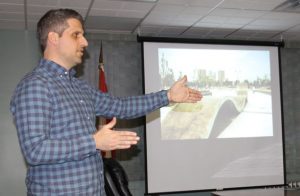Consultants visualize what skateparks about
By Rob Vogt, Local Press Writer
Everett Tetz has a passion for skateboarding and skateparks.
So much so, the former teacher developed a skateboarding curriculum for the school he taught at in Red Deer, and now assists communities in visualizing, designing and building their own skateparks.
He and Trevor Morgan of Newline Skateparks were at the Claresholm town office on Feb. 13, to talk to about 16 people about what a skatepark could be.
Describing his presentation as “Skateboarding 101”, Tetz opened by saying sometimes it’s the journey rather than the destination.
That was certainly the case for Tetz who, as a boy, would never have believed he would work in skateboarding. Now, it is a full industry on its own.
Skateboarding has a rich history more than 50 years old; is a legitimate competitive sport for amateur and professional athletes; is a large industry with a solid foundation; connects millions of people world wide; and is an exciting lifestyle that extends beyond the act of skateboarding itself.
Skateboarding started essentially in 1959 with the first commercially produced skateboard, and has gone through several waves, culminating in what it is today.
Skateboarding today is an established recreational activity. There are more than 10 million skateboarders in North America; and 78 per cent of skateboarders identify themselves as “street” skaters.
“Action Sports”, that is skateboarding, BMX biking and freestyle inline skating, have been the fastest growing area of youth recreation over the last decade.
Tetz said skateboarding is more than just fun though.
As an unstructured exploration of a physical environment, skateboarding: increases cognitive and emotional development; increases complex problem solving; increases physical literacy; promotes a healthy and active lifestyle; has life long participation; has very few barriers; and skateboarding is safer than many other recreational choices available to today’s youth.
Skateboarding has also grown into a full-fledged competitive sport for amateur and professional athletes.
There are a number of different groups locally and nationally organizing amateur skateboarding competitions.
Professional skateboarding today: has many of the world’s top pros who are Canadian; World Cup Skateboarding has been sanctioning professional contests and setting judging standards for over a decade; there are numerous international pro contests in North America; and skateboarding is officially included in the 2020 Olympic Games.
However, there are challenges for skateboarding in the community.
Tetz said the current population is between the ages of five and 24, and 15 per cent can be considered “action sports” participants.
Current skateboarding opportunities include existing skateparks; skate spots; parking lots; plazas; driveways; backyards and garages.
He noted in some communities local businesses are spending money to stop skateboarding and repair damages; young people having confrontations with police and security; and there are concerns about safety of skaters and the general public.
Tetz quoted an article from “Entrepreneur” magazine that stated skateboarders make great entrepreneurs for three reasons: individualism; creativity; rebelliousness.
“The user group has really changed over time,” he said.
Now, there are moms and dads skateboarding; female participation has gone through the roof; and there are still “old guys” like Tetz and Morgan skateboarding.
“It ends up being a pretty cool community and a pretty cool group of people,” Tetz said.
He then explained what a skatepark is.
That is a legitimate place for people to recreate and socialize; a venue for competitive riders to practise and compete; a collection of great “skate spots”, often inspired by an area’s existing urban landscape; and a venue for career skaters to “do their job”.
Skaters will search long and hard for the perfect skate spot.
There are many options.
Skateparks are often populated by a very diverse user group, all with specific technical needs, and users prefer a wide variety of terrain. There are many different types and sizes of skateparks.
It is important to understand the user. There are different skateboarding styles such as street skating; park skating; bowl/pool skating; freestyle; and downhill, with different ability levels such as novice, intermediate and advanced.
Tetz said modern skateparks are no longer rectangles with pre-fabricated ramps.
Now, they are viewed through architecture and sculpture, with formed concrete feature.
“We want the skatepark to reflect the community,” he said, and tell the community’s story. “The heart of this is capturing the story.”
That comes from working with the community.
Tetz and Morgan toured sites in Claresholm, which he said are great, but the key is how do they relate to the rest of the community and existing amenities.
He said the skatepark development journey consists of four phases:
1) Concept design, which includes an introduction/input workshop; online survey; and concept presentation;
2) Detailed design, which includes refining the concept; budget planning; and working drawings;
3) Construction, which includes mobilizing and building;
4) Riding the park, which includes skateboarding and enjoying.
The next steps are getting organized as a community group and securing a site.
Tetz concluded by saying don’t hide your skatepark; fully integrate into the community; and promote shared ownership.

